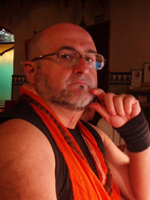There are three main types of breathing that are associated with the ingestion of air and the direction which the air takes toward every one of the areas in which we can divide the lungs: diaphragmatic, which corresponds to the lower part of the lungs, thoracic, corresponding to the medium part of the lungs, and clavicle, which corresponds to the higher area of the lungs. There are poorer types of breathing because of the triangular form of our lungs, for example clavicle breathing is the most deficient for being lesser in volume in this area, and abdominal breathing is the most abundant for having more cubicle area. Each one of these types of breath produce different effects:
Diaphragmatic breathing is the natural form of breathing for a human being since its birth. It’s the type of breathing that allows us the greatest amount of air intake, capable of giving us energy but at the same time allows our mind to be serene. It does not alter or affect our nervous centre instead it tones it. We can use it in Vyayam, Yoga, meditation, relaxation, sexuality and we should use it in a spontaneous way in our daily lives.
Thoracic breathing is good for activating our mind and our nervous system, but maintained for a long time it is very dangerous for the health because it negatively puts pressure on the internal organs, it produces excessive heat and an acceleration of the destructive processes of the body. It excessively overheats our minds, provoking states of irritability and mental agitation.
Clavicle breathing gives us very little air and creates important states of anxiety in the mind. It collapses ours nervous system and the organs and muscles of our body. It demands a greater number of breaths and produces more mind activity.
The breath known as complete or yogic breathing, is that which successively combines all 3 parts together. .
® Written by ~ Swami Shankaratilakananda
(All rights reserved by the author
